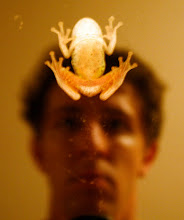I stepped into the garden on Tuesday with a borrowed macro lens- an enlightening experience.
The petals of nascent daisy buds were like silk ribbons carefully woven together.
I watched with crazy clarity as bumblebees burrowed into flowers.
With this powerful new perspective I discovered a tiny tragedy on the pavement. Worms forced out of the soil by recent rain had been stranded to bake in the sun. From my regular height the worms' situation didn't seem so dire, but through the macro lens they were clearly dying.
One of the most amazing aspects of this performance were the veins that were visible beneath the skin of the earthworms. In the sequence below you can see the aortic valve propelling blood into the segment of the worm closest to the camera. To me the violence of this pumping was the surest sign of the worm's imminent demise.
Before I'm accused of animal cruelty, let me say that I did everything I could for all of the worms I could find in the parking lot after I had taken a minute or so to document them. I'm confident I saved at least a few.
This isn't the first bout of compassion I've felt for an earthworm. In high school I produced a small project to commemorate their constant solar-induced deaths. The point I guess was to focus on the microcosmic theatre that plays out all around us without our slightest knowledge.
It seems important to point out that I had a sense of humor about the whole thing. At the same time, it reminded me that death is just as much a surety for you or I as it is for an earthworm.
It seemed to make sense anthropomorphizing the worms. I made xerox transfers of their carcasses and produced a small dry-point etching (which I have since misplaced). I managed to find the sketch for the print buried in my basement- it's pictured below.
Looking back I'm not sure exactly what I wanted the xerox transfers to communicate, but as I see them now it appears as if the worms are disintegrating, or perhaps petrifying- to be remembered like mummies. I guess that's how I see a lot of my work, as a record, like a mummy or a time capsule- a way to preserve the mutable. Perhaps a fitting illustration of this concept is the self portrait I made as a mummy during a printmaking class at RISD, which can be found at my website:
Even such is time, which takes in trust
Our youth, our joys, and all we have,
And pays us but with age and dust;
Who in the dark and silent grave,
When we have wandered all our ways,
Shuts up the story of our days;
And from which earth, and grave, and dust
The Lord shall raise me up, I trust.
I don't trust as much to faith as Sir Walter Ralegh (whose "Author's Epitaph" to "Nature, That Washed Her Hands in Milk" is quoted above) did, but for me it eases the fear of the unknown to memorialize moments of my life, and that of others (and worms) through pictures.
Worms, by the way, get a bad rap in 16th century British poetry- they're always eating people in their graves. Andrew Marvell used worms as a means of convincing his mistress to part ways with her chastity in "To His Coy Mistress":
Thy beauty shall no more be found,
Nor, in they marble vault, shall sound
My echoing song: then worms shall try
That long-preserved virginity,
And your quaint honor turn to dust,
And into ashes all my lust:
The grave's a fine and private place,
But none, I think, do there embrace.
That Marvell had a wild and dirty imagination, but he certainly had not studied his worm facts. He should have known better than to soil the reputation of the annelid- highly asexual creatures. Perhaps contemporary poets could learn from Marvell and pick on someone their own size when trying their game with the opposite sex.
The earthworm project was partly a response to a piece of poetry produced by a teacher I had at the time. She wrote a piece inspired by earthworm anatomy. Earthworms, she told us, possess nine hearts; hence the number of worms in the xerox print above.
I have since found that this is not entirely true- worms have aortic valves that supply oxygenated blood to their segments. It sounded too romantic anyway. As I pointed out for Andrew Marvell above, earthworms are terribly unromantic. They all possess both male and female sexual organs. And besides, a moving intestinal tract can't be expected to woo too much.
Still, the worm poem got me thinking enough to produce the project at the time. Now that worms are back in my mind I'm thinking of making a huge print of one of the earthworm shots. It could serve as a reminder of the mind-boggling diversity of infinitesimal life that carries on always and everywhere.
For those interested in other worm facts: http://urbanext.illinois.edu/worms/facts/index.html
This post is ridiculous.























